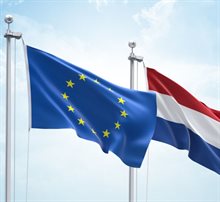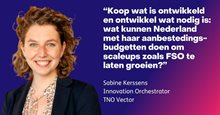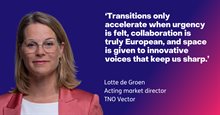Report 'Dutch competitiveness in the light of the Draghi report'.
The Draghi Report compares Europe to global powers. This research translates those insights to the Netherlands and offers recommendations to strengthen our unique economic structure and innovation system.
Three areas
Draghi's findings do not address specific countries. Each country has its own policies on innovation, energy, and strategic independence. In particular, the Standing Committee wanted analysis and advice in three areas: narrowing the innovation gap; decarbonisation and energy prices; and strategic independence and defence.
Range of studies and data sources
‘For our research, we drew on a whole range of domestic and foreign studies and unique data sources about economic and innovation policy, energy, defence, and critical materials. In this process, besides looking at the US and China, we also examined a number of European countries to get a picture of how the Netherlands compares with all these players,’ says TNO Vector researcher Carine van Oosteren.
The Netherlands compared to neighbouring countries
The new research therefore dovetails with recent studies by TNO Vector on innovation and R&D policies in our country and beyond. Last year, for example, a comparative study of our neighbours Germany, Denmark, and Belgium was carried out in order to draw lessons. These three countries meet the standard of investing 3% of GDP annually in research and development (R&D), while the Netherlands lags behind.
Reducing dependency
‘Finland is now even aiming for 4%. They hit the 3% mark when Nokia was still a thriving company. We have ASML as game changer with regard to R&D investment. But you don't want to be too dependent on one player or ecosystem, so you have to prepare for situations when such a dominant business is doing less well. It’s these kinds of issues that we, as a centre for societal innovation and strategy, address,’ adds Carine’s colleague and business developer Cor Jorna.
Learning from Nokia
Late last year, TNO Vector, together with Technisch Weekblad and employers organisation VNO-NCW, identified a top 30 of companies that invest the most in R&D. ASML turns out to be by far the largest investor, with almost three billion euros a year. This study shows that the five largest investors account for almost 30% of R&D spending. This makes us vulnerable in terms of innovation and, as a result, we may become less innovative in the longer term. TNO Vector also carried out a comparative study of ASML versus Nokia and looked at what we can learn from what happened to Nokia as a company.
Private investment lags behind
‘What’s lacking in our country is private investment in research and development, which is lagging behind,’ says Carine. ‘With investments of over 2%, we’re performing below the OECD average and below the EU standard of 3%. Frontrunners such as ASML, Philips, Booking.com, and KPN account for the bulk of these investments. Our R&D-intensive industry is under pressure, with too few new innovative players being added. That’s a trend we need to reverse.’
Vulnerabilities and bright spots
The study exposes our country's vulnerabilities with regard to innovation. There is a lack of venture capital, especially in deep tech. These are technical breakthroughs that help solve complex societal problems. Excessive regulation and unpredictable government policies are also a major stumbling block, undermining the confidence of entrepreneurs and their willingness to invest in innovation. However, there are still plenty of bright spots, according to the researchers.
‘We’re at the top when it comes to our digital infrastructure. We’re doing better overall than many other EU Member States. Our labour productivity is high, even though growth is levelling off. But it’s high time for clear, consistent policies and a firm commitment to the things we’re really good at. Such as AI, quantum technology, and cyber security from the National Technology Strategy (NTS). And when it comes to Defence, that includes radar and aerospace. These are strategic technologies in which we can make a difference and gain competitive advantage, where we can add real value, increase our strategic autonomy.’
Recognising the importance of innovation
The Draghi report unequivocally emphasises the importance of innovation to maintain and increase prosperity and well-being. Government policy is important here, as are initiatives from the business world, but also, according to Carine and Cor, the importance society attaches to innovation.
‘Our research in Germany taught us that innovation and R&D have much greater prestige there than here. The same applies to countries such as Denmark and Finland. Engineers are higher on the social ladder there, so to speak, than they are here.’
International collaboration
The Netherlands appears to be the first country to have made a strategic translation of the Draghi report to its own situation. Through EARTO, the European Association of Research and Technology Organisations, and Neth-ER, TNO Vector wants to draw attention to it. ‘Public and private collaboration with other countries and research institutions is crucial for our country. It has given us a lot. We already collaborate on many meaningful EU projects. At this juncture, we have to put extra effort into collaboration.’





